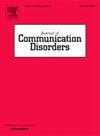Relationships between hearing, auditory processing, and communication in children diagnosed with auditory neuropathy spectrum disorder
IF 2.1
3区 医学
Q2 AUDIOLOGY & SPEECH-LANGUAGE PATHOLOGY
引用次数: 0
Abstract
Objectives
The objectives of this study were to evaluate the relationships between auditory processing, speech discrimination, and listening and communication abilities in children diagnosed with auditory neuropathy spectrum disorder (ANSD) compared to those with normal hearing.
Methods
This was a case-control study involving seventeen participants with a diagnosis of ANSD who used spoken language as their primary mode of communication and wore hearing aids or were unaided and 21 normally hearing controls. All underwent a battery of behavioural measures of hearing, speech perception and auditory processing skills. Their parents filled in a series of questionnaires to evaluate listening and communication abilities. Group differences were evaluated, and hierarchical linear regression was carried out to assess the extent to which auditory measures predicted parent report scores.
Results
Slow-rate amplitude modulation detection (AMD) was an important predictor of listening and communication abilities over and above the pure-tone audiogram in children diagnosed with ANSD. There was a significant relationship between the pure-tone audiogram and the ability to discriminate speech in quiet but not in noise. Children in the ANSD group had more difficulty completing tests of auditory processing ability or performed significantly more poorly than the control group for most tasks.
Conclusions
This study confirms that outcomes for children diagnosed with ANSD are heterogeneous, and provides new information about real world listening and communication abilities. These findings will be useful for clinicians counselling families of newly diagnosed infants and providing management for children with a diagnosis of ANSD.
听神经病变谱系障碍患儿听力、听觉加工和交流的关系。
目的:本研究的目的是评估听觉神经病变谱系障碍(ANSD)患儿与正常听力患儿的听觉加工、言语辨别、听力和沟通能力之间的关系。方法:这是一项病例对照研究,涉及17名以口语为主要交流方式并佩戴助听器或不佩戴助听器的被诊断为ANSD的参与者和21名听力正常的对照组。所有人都接受了一系列听力、言语感知和听觉处理技能的行为测试。他们的父母填写了一系列问卷来评估孩子的听力和沟通能力。评估各组差异,并进行层次线性回归来评估听觉测量预测家长报告得分的程度。结果:慢速调幅检测(慢速调幅检测)比纯音听力图更能预测ANSD患儿的听力和交流能力。纯音听力图与安静环境中辨别语音的能力有显著的关系,而在嘈杂环境中则无显著的关系。在大多数任务中,与对照组相比,患有ANSD的儿童更难完成听觉处理能力测试,或者表现明显更差。结论:本研究证实了被诊断为ANSD的儿童的结果是异质的,并提供了关于现实世界倾听和沟通能力的新信息。这些发现将有助于临床医生为新诊断婴儿的家庭提供咨询,并为诊断为ANSD的儿童提供管理。
本文章由计算机程序翻译,如有差异,请以英文原文为准。
求助全文
约1分钟内获得全文
求助全文
来源期刊

Journal of Communication Disorders
AUDIOLOGY & SPEECH-LANGUAGE PATHOLOGY-REHABILITATION
CiteScore
3.30
自引率
5.90%
发文量
71
审稿时长
>12 weeks
期刊介绍:
The Journal of Communication Disorders publishes original articles on topics related to disorders of speech, language and hearing. Authors are encouraged to submit reports of experimental or descriptive investigations (research articles), review articles, tutorials or discussion papers, or letters to the editor ("short communications"). Please note that we do not accept case studies unless they conform to the principles of single-subject experimental design. Special issues are published periodically on timely and clinically relevant topics.
 求助内容:
求助内容: 应助结果提醒方式:
应助结果提醒方式:


